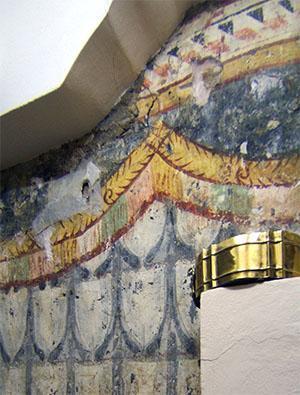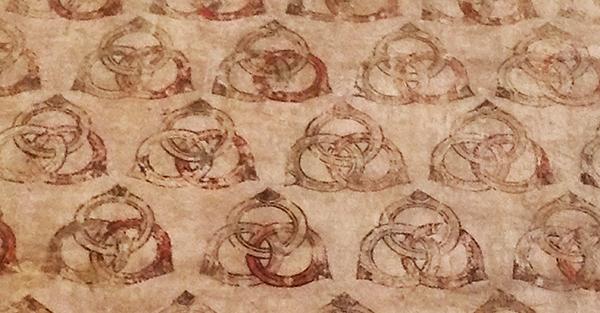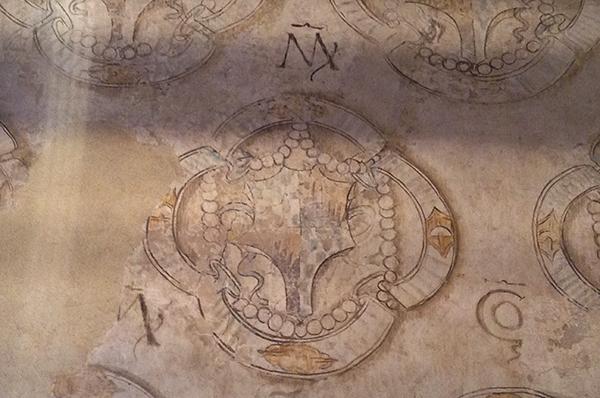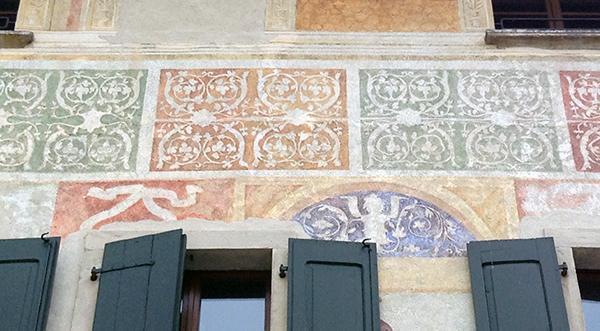False tapestries
Post from EditorialsIn some historic buildings you can find false tapestries painted with geometric, heraldic or vegetable motif that inspire you for the decoration of your house.
Origin of false tapestries
 In many fine buildings (churches, castles, houses and palaces of the merchant class) of medieval origin you can rediscover large fragments of faux painted interior, often of great value.
In many fine buildings (churches, castles, houses and palaces of the merchant class) of medieval origin you can rediscover large fragments of faux painted interior, often of great value.
It is known fact that buildings of this period were quite uncomfortable, dark and exposed to air currents: the windows were in fact few, mostly small and without glasses (extremely expensive and therefore reserved almost exclusively to the main churches): therefore in bad season the cold and the humidity made the rooms very uncomfortable.
To try to solve this problem and beautify the environment otherwise too bare, it was then a widespread custom to cover the walls with tapestries, heavy fabrics or even fur. However, being also this solution decidedly expensive, in many cases it resorted to pictorial imitations of such apparatuses.
Types of false tapestries
 Their appearance is obviously very varied, and changes depending on the intended use of the building in which they were (the church, private home, feudal castle) and also on the period they were created.
Their appearance is obviously very varied, and changes depending on the intended use of the building in which they were (the church, private home, feudal castle) and also on the period they were created.
In fact, with the passing of time these decorations were extended not only to the large splayed windows (due to the presence of very thick load-bearing walls), but also the facades of buildings, as seen for example in the fifteenth century Palazzo Ugugieri in downtown Siena or in some houses in Spilimbergo (Pordenone).
In addition, the designs show a constant evolution: from the twelfth or thirteenth century are in fact attested mainly geometric patterns as lozenges, squares or simple lines, or the pictorial imitation of curtains and fur (especially squirrel, it proceeds from the winter coat of a particular Siberian squirrel considered particularly valuable).
From the fourteenth and fifteenth century we see instead plant motifs, plots of various types, miniatures in medallions, scrolls, coats of arms and heraldic devices, which in noble palaces and castles are predominant: we find good examples in the castles of Bazzano (Bologna) and Vignola (Modena), or in the Florentine Palazzo Davanzati.
Later, in the sixteenth and seventeenth century the false tapestries return to approach the figurative repertoire typical of the textile art: in fact the curtains reappear, drapery by far more natural and realistic then the medieval examples, and of course the ornamental motifs interwoven and/ or of natural inspiration typical of the precious silk, brocade and lampas used in upholstery.
In the eighteenth and nineteenth centuries, with the replacement of expensive upholstery fabric with cheaper wallpapers, these decorations were relegated to the most modest houses or medium-small bourgeois.
The figurative repertoire expands greatly, since in addition to the now traditional textile designs and floral motifs also appears the Egyptian pattern as sphinxes or hieroglyphics, the grotesque (both very popular during the French Revolution and the Napoleonic era, following the discovery of the archaeological excavations of Pompeii and Herculaneum and the Egyptian Campaign), and finally the so-called chinoiserie, namely the representation of figurative elements (real or more often imaginary) inspired by the Orient, including, for example, architecture Chinese pagodas, dragons and women in kimonos.
Technical execution of false tapestries
The realization techniques are obviously the same as found in the realization of the decorated plasters, namely the fresco, the lime paint (or cool-dry) and tempering.
Of course, as with all other murals the fresco guaranteed a remarkable speed of execution and virtually unlimited endurance, but did not allow errors or changes in the course of work, and also required skilled work, making it very expensive.
Cheapest were instead the lime paint and tempera: These techniques also turned the undoubted advantages of allowing corrections and modifications also finished work and does not require skilled labor. However, tempering does not lend itself very well to make paintings durable, because it is so sensitive to moisture and water infiltration, that often to clear or severely damage a painting it is enough to just rub it with a wet sponge.
In the Middle Ages and Renaissance, once prepared the surface and, in the case of geometric and/ or modular pattern set up a network of any guidelines, it passed to the creation of fake wallpaper by painting the figures one by one with a brush.
In fact, looking at the decorations with heraldic themes often are noticed not only the individual strokes, but slight differences or uncertainties of performance in a pretend upholstery in the Castle of Bazzano (pictured above) are such very obvious mistakes in the space the individual figures in geometric construction of the medallions and even spelling the motto visible in the title block, surely due to the use of workers little educated or completely illiterate.
In later times the execution process instead was greatly simplified (and the result often much improved) by resorting to the technique of stencilling, which presupposes the use of one or more different timbres (typically one for each color) to realize the design, and the stencil, which replaces the stamps with special masks within which to distribute the color.
Decorate the house with a false upholstery
 The false tapestries have never completely fallen into disuse, and indeed they can be validly used to decorate the house, especially if furnished in country, ethnic, shabby or colonial style.
The false tapestries have never completely fallen into disuse, and indeed they can be validly used to decorate the house, especially if furnished in country, ethnic, shabby or colonial style.
Depending on the case, the decoration will then cover the entire wall (assuming the appearance of a real upholstery), cover only the frames of doors and windows or ultimately constitute an elegant frieze below the ceiling.
Of course, the theme chosen must be in tune with both the environment and the style of furniture, both with the type of decoration: a frieze or frames lend themselves very well wreaths plant, the Greek, the plots or Celtic the figurative elements such as small landscapes and / or sequences of characters. In the case of real false tapestries, are instead shown little drawings blocks to be repeated several times, such as fruits, kitchen tools and still lifes (for cooking), floral motifs, grotesque and chinoiserie (for the living room and the bedroom ).
The possible techniques are two: the stencil and stencilling.  The colors and accessories (brushes and pads) are easily available in hobby shops and do-it-yourself; while stamps and templates can be purchased ready for use or constructible handcrafted with different materials: cardboard or acetate film for stencil masks, and wood, cork, rubber, linoleum, sponge or even half a potato for the stamps Stencil.
The colors and accessories (brushes and pads) are easily available in hobby shops and do-it-yourself; while stamps and templates can be purchased ready for use or constructible handcrafted with different materials: cardboard or acetate film for stencil masks, and wood, cork, rubber, linoleum, sponge or even half a potato for the stamps Stencil.
In general, you have to consider that:
- You need a stamp or mask for each color pattern selected;
- In the case of several stamps, to prevent stains and smudges before moving on to the next color must be allowed to dry thoroughly those already laid;
- To avoid drawings are not perfectly aligned, it is advantageous to create appropriate references (eg small pencil marks to erase the work is finished) to overlay correctly stamps or templates.
79734 REGISTERED USERS










